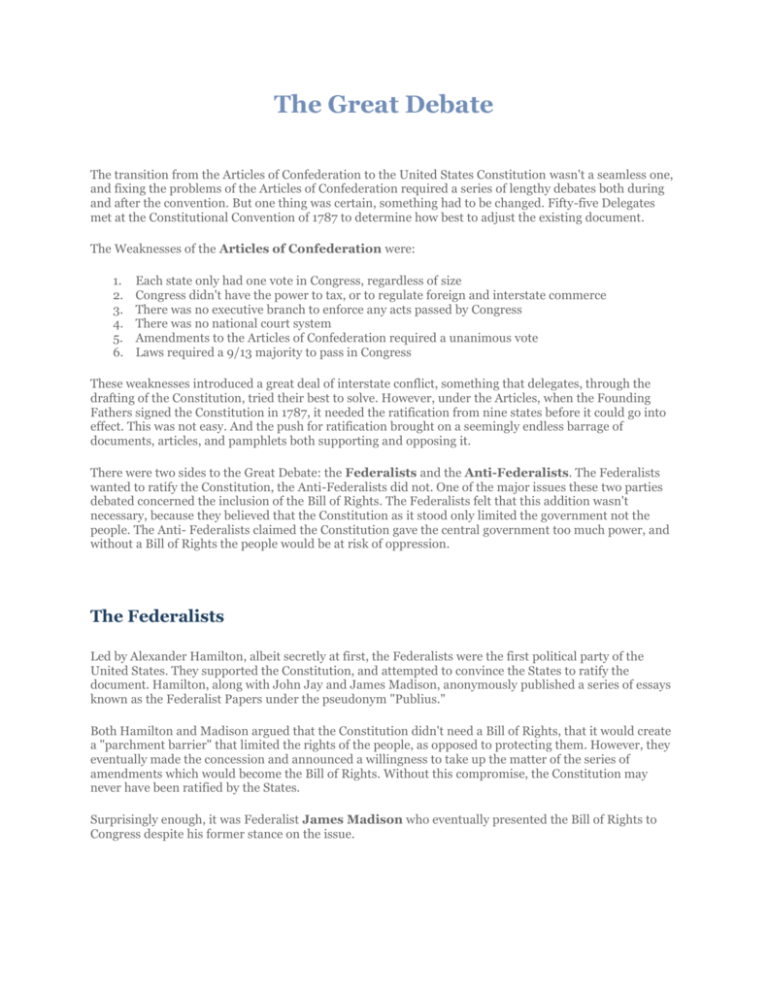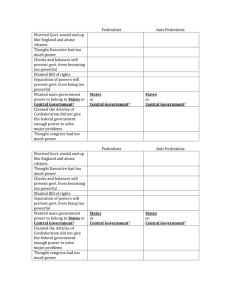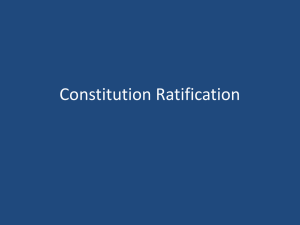Anti Federalists
advertisement

The Great Debate The transition from the Articles of Confederation to the United States Constitution wasn't a seamless one, and fixing the problems of the Articles of Confederation required a series of lengthy debates both during and after the convention. But one thing was certain, something had to be changed. Fifty-five Delegates met at the Constitutional Convention of 1787 to determine how best to adjust the existing document. The Weaknesses of the Articles of Confederation were: 1. 2. 3. 4. 5. 6. Each state only had one vote in Congress, regardless of size Congress didn't have the power to tax, or to regulate foreign and interstate commerce There was no executive branch to enforce any acts passed by Congress There was no national court system Amendments to the Articles of Confederation required a unanimous vote Laws required a 9/13 majority to pass in Congress These weaknesses introduced a great deal of interstate conflict, something that delegates, through the drafting of the Constitution, tried their best to solve. However, under the Articles, when the Founding Fathers signed the Constitution in 1787, it needed the ratification from nine states before it could go into effect. This was not easy. And the push for ratification brought on a seemingly endless barrage of documents, articles, and pamphlets both supporting and opposing it. There were two sides to the Great Debate: the Federalists and the Anti-Federalists. The Federalists wanted to ratify the Constitution, the Anti-Federalists did not. One of the major issues these two parties debated concerned the inclusion of the Bill of Rights. The Federalists felt that this addition wasn't necessary, because they believed that the Constitution as it stood only limited the government not the people. The Anti- Federalists claimed the Constitution gave the central government too much power, and without a Bill of Rights the people would be at risk of oppression. The Federalists Led by Alexander Hamilton, albeit secretly at first, the Federalists were the first political party of the United States. They supported the Constitution, and attempted to convince the States to ratify the document. Hamilton, along with John Jay and James Madison, anonymously published a series of essays known as the Federalist Papers under the pseudonym "Publius." Both Hamilton and Madison argued that the Constitution didn't need a Bill of Rights, that it would create a "parchment barrier" that limited the rights of the people, as opposed to protecting them. However, they eventually made the concession and announced a willingness to take up the matter of the series of amendments which would become the Bill of Rights. Without this compromise, the Constitution may never have been ratified by the States. Surprisingly enough, it was Federalist James Madison who eventually presented the Bill of Rights to Congress despite his former stance on the issue. The Anti-Federalists In the ratification debate, the Anti-Federalists opposed to the Constitution. They complained that the new system threatened liberties, and failed to protect individual rights. The Anti-Federalists weren't exactly a united group, but instead involved many elements. One faction opposed the Constitution because they thought stronger government threatened the sovereignty of the states. Others argued that a new centralized government would have all the characteristics of the despotism of Great Britain they had fought so hard to remove themselves from. And still others feared that the new government threatened their personal liberties. During the push for ratification, many of the articles in opposition were written under pseudonyms, such as "Brutus”, “Centinel”, and "Federal Farmer”," but some famous revolutionary figures such as Patrick Henry came out publicly against the Constitution. Although the Anti-Federalists were unsuccessful in the prevention of the adoption of the Constitution, their efforts were responsible for the creation and implementation of the Bill of Rights. Reaction in the States In Rhode Island resistance against the Constitution was so strong that civil war almost broke out on July 4, 1788, when anti-federalist members of the Country Party led by Judge William West marched into Providence with over 1,000 armed protesters. Although not all of the States underwent the extreme of the Rhode Island case, many of them had a bit of difficulty deciding which side they were on. This uncertainty played a major role in the ratification convention in Massachusetts. Finally, after long debate, a compromise (the "Massachusetts Compromise”) was reached. Massachusetts would ratify the Constitution, and in the ratifying document strongly suggest that the Constitution be amended with a bill of rights. Four of the next five states to ratify, including New Hampshire, Virginia, and New York, included similar language in their ratification instruments. As a result, after the Constitution was enacted, Congress sent a set of twelve amendments to the states. Ten of these amendments were immediately ratified into the Bill of Rights.








